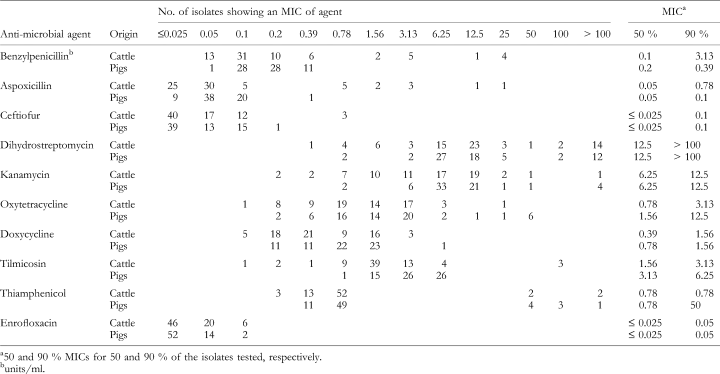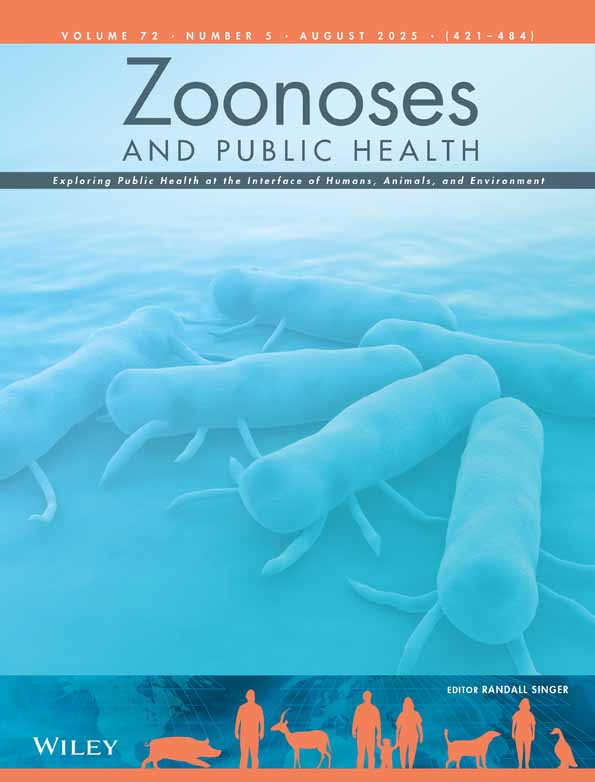Antimicrobial Susceptibility of Pasteurella multocida Isolated From Cattle and Pigs
Abstract
Minimum inhibitory concentrations (MICs) of 10 antimicrobial agents were determined for Pasteurella multocida from cattle and pigs (72 and 68 isolates, respectively). Higher MICs were observed with oxytetracycline, doxycycline, tilmicosin and thiamphenicol for porcine isolates than for bovine isolates. Enrofloxacin was the most active, with an MIC for 90 % of the isolates (MIC90) of 0.05 μg/ml for both bovine and porcine isolates. Aspoxicillin exhibited the same excellent activity against penicillin-susceptible isolates as ceftiofur, with MICs ranging from ≤ 0.025 to 0.1 μg/ml. Aminoglycosides were less active, with an MIC90 of > 100 μg/ml for both bovine and porcine isolates.
Introduction
Pasteurella multocida is a common inhabitant of the pig’s nasal flora and causes various diseases involving pneumonia, septicepia, nephritis, etc. (Magwood et al., 1969; Allen et al., 1991; Pijoan, 1994). This organism is also isolated from pigs with atrophic rhinitis (Cowart et al., 1989). Pneumonic pasteurellosis is one of the most common costly diseases of pigs (Pijoan, 1994). Antimicrobial therapy is the major effective method for treating animal pasteurellosis and a wide variety of antimicrobial agents has been clinically available. Antimicrobial susceptibility testing has been conducted world-wide, by determining minimum inhibitory concentrations (MICs), for either porcine isolates (Yamamoto et al., 1990; Iwamatsu et al., 1991; Gutiérrez Martin and Rodríguez Ferri,,1993; Raemdonck et al., 1994; Blackall et al., 1995; Salmon et al., 1995; Bousquet et al., 1997) or bovine isolates (Stephens et al., 1993; Watts et al., 1994). However, the MIC antimicrobial susceptibility data compared between bovine and porcine isolates are scant (Hörmansdorfer and Bauer, 1998). Most antimicrobial agents used for the treatment of bovine pasteurellosis are also approved for use in pigs, but their amount and route of administration differ more or less between cattle and pigs. How antimicrobial use has had an influence on the emergence of resistance in P. multocida could be assessed by determining MICs of isolates from these two species of animals. Recent MIC data are also indispensable for the appropriate use of antimicrobial agents and to monitor changes in antimicrobial susceptibility. The purposes of the present study were to determine MICs of 10 antimicrobial agents currently used against recent isolates and to assess if there was any difference in the MIC antimicrobial susceptibility data between bovine and porcine isolates.
Materials and Methods
Isolates
A total of 140 isolates of P. multocida was used. The isolates were isolated by staff of Livestock Hygiene Service Centres in 31 of 45 prefectures across the country during the period from 1994 to 1998. Of these, 72 isolates were from cattle in 24 prefectures: 34 isolates from pulmonary lesions, 31 from nasal exudates or nasal swabs, two from mastitis, and five from unknown sources. The remaining 68 isolates were from pigs in 23 prefectures: 53 isolates from pulmonary lesions, 13 from nasal exudates or nasal swabs, two from unknown sources. Pasteurella multocida was identified on the basis of colonial morphology, microscopic examination and biochemical characteristics (Mannheim, 1983). The isolates were grown overnight in brain heart infusion broth (Difco Laboratories, Detroit, MI, USA), mixed with 10 % skim milk at a ratio of 1 : 1, and stored at –85°C until used.
Antimicrobial susceptibility testing
The antimicrobial agents tested were benzylpenicillin, dihydrostreptomycin, kanamycin (Meiji Seika Kaisha Ltd, Tokyo, Japan); aspoxicillin (Tanabe Seiyaku Co. Ltd, Osaka, Japan); ceftiofur (Pharmacia & Upjohn Inc., Kalamazoo, MI, USA); doxycycline, oxytetracycline (Pfizer Pharmaceuticals Inc., Tokyo, Japan); tilmicosin (Shionogi & Co. Ltd, Osaka, Japan); thiamphenicol (Eisai Ltd, Tokyo, Japan); and enrofloxacin (Bayer AG, Leverkusen, Germany).
MICs were determined by the agar dilution method according to the Japan Society of Chemotherapy (Mitsuhashi et al., 1981), using Mueller-Hinton agar (Difco Laboratories). The isolates were grown at 37°C for 18 h in Mueller-Hinton broth and diluted 10–3 in physiological saline as the inocula. A multipoint inoculator that delivers 5 μg (Sakuma Co. Ltd, Tokyo, Japan) was used to spot the inocula. The plates were incubated at 37°C for 18 h. The MIC was taken as the lowest concentration to prevent growth. Resistance breakpoints of penicillins and thiamphenicol were determined on the basis of the MIC population of the isolates. Breakpoints of aminoglycosides were those defined by Yamamoto et al. (1990) and Iwamatsu et al. (1991). For tetracyclines, MICs of ≥ 12.5 μg/ml were defined as resistant, considering the breakpoints proposed by Gutiérrez Martin and Rodríguez Ferri ,1993) and Bousquet et al. (1997). MICs of tilmicosin were defined as susceptible (≤ 6.25 μg/ml), intermediately susceptible (12.5–25 μg/ml) or resistant (> 25 μg/ml), as described by Stephens et al. (1993) and Blackall et al. (1995).
Results
The MICs of 10 antimicrobial agents for bovine and porcine isolates are listed in Table 1. The MIC ranges of the penicillins were wider among bovine isolates than among porcine isolates. All porcine isolates were susceptible to benzylpenicillin, with MICs ranging from 0.05 to 0.39 units/ml, but 12 (16.7 %) of 72 bovine isolates were intermediately susceptible (MICs, 1.56–3.13 units/ml) or resistant (MICs, 12.5–25 units/ml) to benzylpenicillin. These 12 isolates were also intermediately susceptible (MICs, 0.78–3.13 μg/ml) or resistant (MICs, 12.5–25 μg/ml) to aspoxicillin. Ceftiofur was highly active, with an MIC of 90 % of the isolates (MIC90) of 0.1 μg/ml for both bovine and porcine isolates. However, three bovine isolates had an MIC of 0.78 μg/ml, considered intermediately susceptible. Aspoxicillin exhibited the same excellent activity against penicillin-susceptible isolates as ceftiofur, with MICs ranging from ≤ 0.025 to 0.1 μg/ml.

Although the aminoglycosides were less active than other classes of antimicrobial agent, the susceptibility to aminoglycosides did not differ between bovine and porcine isolates. Fourteen (19.4 %) bovine isolates and 12 (17.6 %) porcine isolates were resistant to dihydrostreptomycin (MICs, > 100 μg/ml). Resistance to kanamycin occurred in one (1.4 %) bovine isolate and four (5.9 %) porcine isolates (MICs, > 100 μg/ml).
MICs of oxytetracycline were higher among porcine isolates than among bovine isolates, particularly MIC90s, being 12.5 versus 3.13 μg/ml. Resistance to oxytetracycline was found in one (1.4 %) bovine isolate and eight (11.8 %) porcine isolates. Doxycycline was more active than oxytetracycline, with an MIC of 50 % of the isolates (MIC50) being twice as high for porcine isolates than for bovine isolates.
Tilmicosin was moderately active. The MIC50 and MIC90 for porcine isolates were twice as high as those for bovine isolates. MIC peaks were situated at higher concentrations among porcine isolates than among bovine isolates, but MICs exceeding 6.25 μg/ml were not observed with any porcine isolates, indicating that they were all susceptible to this antibiotic. There were three bovine isolates harbouring high-level resistance to tilmicosin (MIC, 100 μg/ml).
MICs of thiamphenicol were in the range of 0.2–0.78 μg/ml for the susceptible isolates. The MIC90 of thiamphenicol was much higher for porcine isolates, of which eight (11.8 %) were resistant to this compound (MIC, ≥ 50 μg/ml).
Enrofloxacin was the most active among the antimicrobial agents used in this study, with an MIC90 of 0.05 μg/ml for both bovine and porcine isolates. None of the isolates was found to harbour resistance to this compound.
Eighteen (25.0 %) bovine isolates and 22 (32.4 %) porcine isolates were resistant to one or more of the major antimicrobial agents benzylpenicillin, dihydrostreptomycin, oxytetracycline, tilmicosin and thiamphenicol. There were no common resistance patterns between bovine and porcine isolates. The most frequently occurring resistance patterns among bovine isolates were for dihydrostreptomycin and benzylpenicillin/dihydrostreptomycin, accounting for six isolates each, followed by benzylpenicillin and benzylpenicillin/tilmicosin/thiamphenicol, accounting for two isolates each. Among porcine isolates, the most frequently occurring resistance pattern was for oxytetracycline, accounting for 10 isolates, followed by thiamphenicol, accounting for four isolates (data not shown).
Discussion
Among the antimicrobial agents were ceftiofur and enrofloxacin that were highly active against P. multocida. This finding is in good agreement with those of Gutiérrez Martin and Rodríguez Ferri ,1993), Hewett (1994), Raemdonck et al. (1994), Watts et al. (1994), Salmon et al. (1995) and Blackall et al. (1996). Aspoxicillin, developed for the treatment of pneumonic pasteurellosis of cattle and pigs in Japan, was found to exhibit the same excellent activity against penicillin-susceptible isolates as ceftiofur. Although resistance to enrofloxacin was not found in any isolates, as in Gutiérrez Martin and Rodríguez Ferri ,1993), Salmon et al. (1995), and Aarestrup et al. (2000), the use of fluoroquinolones in food animals has been a matter of debate in terms of the emergence of resistance in zoonotic bacteria such as Salmonella and Campylobacter (WHO, 1998; Aarestrup et al., 2000). The aminoglycosides showed poor activity against P. multocida, compared with other classes of antimicrobial agent, as reported by Gutiérrez Martin and Rodríguez Ferri ,1993). The high frequency of resistance to dihydrostreptomycin observed among bovine and porcine isolates is in agreement with Hörmansdorfer and Bauer (1998) who reported that 50 and 100 % of bovine and porcine isolates, respectively, had been resistant to streptomycin, suggesting that dihydrostreptomycin is no longer recommended as a drug of choice for the treatment of pasteurellosis.
MICs of tetracyclines and tilmicosin tended to be higher among porcine isolates than among bovine isolates. Higher MICs of oxytetracycline and tilmicosin for porcine isolates could be attributed to more frequent use of tetracyclines and macrolides in pig husbandry, particularly via feed. Higher MICs of doxycycline for porcine isolates were considered to be due to a cross-resistance between oxytetracycline and doxycycline (Bousquet et al., 1997). Tilmicosin has only been utilized in the treatment of porcine pneumonia since November 1994, and thus higher MICs for porcine isolates might reflect the use of tylosin, a structurally related macrolide, that has persisted for more than 30 years as medicated feed or a growth-promoting agent in pigs. Tilmicosin had not been used in cattle before July 1996. The reason for the emergence of three bovine isolates with high-level resistance to tilmicosin is not clear, but they may have acquired resistance to other macrolides such as erythromycin and tylosin. Watts et al. (1994) also observed high-level resistance to tilmicosin among bovine isolates in the USA where tilmicosin had not been introduced. Higher MICs of thiamphenicol for porcine isolates are also considered to be due to its use for at least 20 years as medicated feed in pig husbandry.
Overall, there were differences in MICs and resistance patterns between bovine and porcine isolates for some antimicrobial agents, reflecting the amount and routes of administration exposed to these two animal species. However, most of the P. multocida isolates were considered still susceptible to antimicrobial agents in current use, excluding the aminoglycosides. The use of antimicrobial agents in food animals to minimize the emergence of resistance not only in target pathogens but in zoonotic bacteria in terms of human health is warranted in the future.
Acknowledgements
We thank the staff of the Livestock Hygiene Service Centres across the country for providing us with the P. multocida isolates used.




